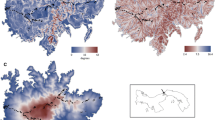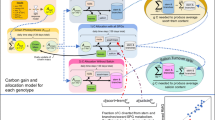Summary
Growth, herbivory and defenses were studied for 41 common tree species in a lowland rainforest in Panama. Species represented a range of shade tolerance, but all individuals were measured in light gaps to control for environmental conditions and the availability of herbivores. Species growth rates and leaf lifetimes differed by almost 50-fold and were related to the degree of shade tolerance. Various measures of plant growth were significantly negatively correlated with an estimate of defense investment, and significantly positively correlated with rates of herbivory. Species with long-lived leaves had significantly higher concentrations of immobile defenses such as tannins and lignins. These data support current hypotheses that the intrinsic growth rate of a species evolutionarily determines the optimal amount and type of defense.
Similar content being viewed by others
References
Bradshaw AD, Chadwick MJ, Jowett D, Snydon RW (1964) Experimental investigations into the mineral nutrition of several grass species. IV. J Ecol 52:665–676
Brokaw NVL (1980) Gap-phase regeneration in aneotropical forest. Dissertation. University of Chicago, Chicagi Ill, USA
Brokaw NVL (1982) The definition of treefall gap and its effect on measures of forest dynamics. Biotropica 11:158–160
Brokaw NVL (1985) Gap-phase regeneration in a tropical forest. Ecology 66:682–687
Bryant JP (1987) Resource availability: Implications for constitutive and long-term inducible defenses in foliage of woody plants. In: Spencer K (ed) AIBS Symposium Volume (in press)
Bryant JP, Chapin III FS, Klein DR (1983) Carbon/nutrient balance of boreal plants in relation to vertebrate herbivory. Oikos 40:357–368
Bryant JP and Kuropat PJ (1980) Selection of winter forage by subarctic browsing vertebrates: the role of plant chemistry. Ann Rev Ecol Syst 11:261–285
Cates RG (1975) The interface between slugs and wild ginger: Some evolutionary aspects. Ecology 56:391–400
Chapin III FS (1980) The mineral nutrition of wild plants. Annu Rev Ecol Syst 11:261–285
Chazdon RL, Fetcher N (1984) Light environments of tropical forests. In Medina E, Mooney HA, Vazquez-Yanes C (eds) Physiolocal ecology of plants of the wet tropics. Junk, Boston, Mass, pp 27–36
Chew FS, Rodman JE (1979) Plant resources for chemical defense. In: Rosenthal GA, Janzen DH (eds) Herbivores: Their interaction with secondary plant metabolites. Academic Press, New York, pp 271–307
Coley PD (1981) Ecological and evolutionary responses of tropical trees to herbivory: a quantitative analysis of grazing damage, plant defenses and growth rates. Dissertation. University of Chicago, Chicago, Ill
Coley PD (1983) Herbivory and defensive characteristics of tree species in a lowland tropical forest. Ecol Mongr 53:209–233
Coley PD (1986) Costs and benefits of defense by tannins in a neotropical tree. Oecologia 70:238–241
Coley PD, Bryant JP, Chapin III FS (1985) Resource availability and plant anti-herbivore defense. Science 230:895–899
Cooper SM and Owen-Smith N (1985) Condensed tannins deter feeding by browsing ruminants in a South African Savanna. Oecologia 67:142–146
Croat TB (1978) Flora of Barro Colorado Island. Stanford University Press, Stanford, Calif
Denslow JS (1980) Gap partitioning among tropical rainforest trees. Biotropica [Suppl] 12:47–55
Feeny PP (1976) Plant apparency and chemical defense. Rec Adv Phytochem 10:1–40
Foster RB, Brokaw NVL (1982) Structure and history of vegetation of Barro Colorado Island. In: Leigh EG, Rand AS, Windsor DM (eds) The ecology of a tropical forest: seasonal rhythms and long-term changes. Smithsonian Institution Press, Washington DC, pp 67–81
Foulds W, Grime JP (1972) The responses of cyanogenic and acyanogenic phenotypes of Trifolium repens to soil moisture supply. Heredity 28:181–187
Furness SB, Grime JP (1982) Growth rate and temperature responses in bryophytes II. A comparative study of species of contrasted ecology. J Ecol 70:525–536
Goering HK, Van Soest PJ (1975) Forage fiber analysis: apparatus, reagents, procedures and some applications. Agricultural Handbook No. 379, USDA, Washington DC
Grime JP (1977) Evidence for the existence of three primary stategies in plants and its relevance to ecological and evolutionary theory. Am Nat 111:1169–1194
Grime JP (1979) Plant strategies and vegetation processes. Wiley and Sons, Chichester
Grime JP, Hunt R (1975) Relative growth-rate: its range and adaptive significance in a local flora. J Ecol 63:393–422
Gulmon SL, Mooney HA (1986) Costs of defense on plant productivity. In: Givnish TJ (ed) On the economy of plant form and function. Cambridge University Press, Cambridge, pp 681–698
Hartshorn GS (1980) Neotropical forest dynamics. Biotropica [Suppl] 12:23–30
Janzen DH (1974) Tropical blackwater rivers, animals and mast fruiting by the Dipterocarpaceae. Biotropica 6:69–103
Leigh EG, Rand AS, Windsor DM (eds) (1982) Ecology of a tropical forest: seasonal rhythms and long-term changes. Smithsonian Institution Press, Washington DC
MacLean SF, Jensen TJ (1984) Food plant selection by insect herbivores: the role of plant growth form. Oikos 44:211–221
McKey DB (1979) The distribution of secondary compounds within plants. In: Rosenthal GA, Janzen DH (eds) Herbivores: their interactions with secondary plant metabolites. Academic Press, New York, pp 55–133
McKey DB (1984) Interaction of the ant-plant Leonardoxa africana (Caesalpiniaceae) with its obligate inhabitants in a rainforest in Cameroon. Biotropica 16:81–99
McKey DB, Gartlan JS (1981) Food selection by black colobus monkeys (Colobus satanus) in relation to plant chemistry. Biol J Linn Soc 16:115–146
McKey DB, Waterman PG, Mbi CN, Gartlan JS, Strusaker TT (1978) Phenolic content of vegetation in two African rain-forests: ecological implications. Science 202:61–64
Owen-Smith N, Cooper SM (1986) Classifying African savanna trees and shrubs in terms of their palatability for browsing ungulates. In: Flinders J, Provenza FD (eds) Plant/herbivore interactions. Proc Fourth Annual Wildland Shrub Symposium (in press)
Parsons RF (1968) The significance of growth-rate comparisons for plant ecology. Am Nat 102:595–597
Pennig de Vries FWT (1975) The costs of maintenance processes in plant cells. Ann Bot (London) 39:77–92
Rathcke B (1985) Slugs as generalist herbivores: tests of three hypotheses on plant choice. Ecology 66:828–836
Rhoads DF, Cates RG (1976) Toward a general theory of plant antiherbivore chemistry. Rec Adv Phytochem 10:168–213
Southwood TRE, Brown VK, Reader PM (1986) Leaf palatability, life expectancy and herbivore damage. Oecologia (Berlin) 70:544–548
Vandenberg P, Matzinger DF (1970) Genetic diversity and heterosis in Nicotiana. III Crosses among tobacco introductions and flue-cured varieties. Crop Sci 10:437–440
Author information
Authors and Affiliations
Rights and permissions
About this article
Cite this article
Coley, P.D. Effects of plant growth rate and leaf lifetime on the amount and type of anti-herbivore defense. Oecologia 74, 531–536 (1988). https://doi.org/10.1007/BF00380050
Received:
Issue Date:
DOI: https://doi.org/10.1007/BF00380050




